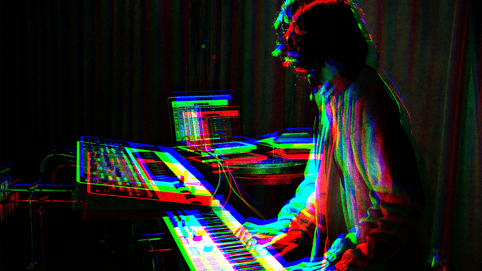When it comes to editing audio, whether that be in videos, podcasts, or anything else, there are surprisingly more terms to learn than you might expect. Terms like “equalization,” “panning,” and “compression” come to mind, as well as terms for types of audio and noise.
In particular, there can be a lot of confusion around terms like “white noise” versus “green noise” or any other colors for that matter. Yet, while white noise might be the most recognizable term, other types of ambient background noise, such as green noise, are also gaining popularity.
If you aren’t familiar with green noise, it’s actually a pretty interesting and important type of audio that can be used for everything from short and feature films to YouTube ASMR videos. Let’s explore what green noise is, how it can be used in your content, and even provide you with some ambient royalty free green noise music tracks to use in your projects.
What is Green Noise?
So, to kick things off, let’s go over some basic definitions. Green noise is a type of ambient background audio that is often associated with outdoor lifestyle and nature content. Some examples of ambient green noise include music tracks that feature sounds of wind in trees, water in streams, or rain in meadows.
What is Green Noise good for?
Green noise, as a term, is often used in conjunction with relaxing sounds and ASMR videos. Often, people use green noise for sleep, relaxation or meditation. If you’ve ever used a sleep noise machine, green noise could be one of the settings that you can choose from.
What is the green noise frequency?
For those looking for more technical information regarding green noise, it’s worth pointing out that green noise is usually found around the 400-600 Hz mark and can be categorized as a mid-frequency tone.
This mid-frequency range is often associated with other relaxing sounds and soundtracks and can be a great option for those looking to create content that is relaxing, stress-free, and soothing.
What is the difference between green noise and white noise?
Mentioned above, green noise can either be viewed as a type of white noise or a separate type of audio unto itself. White noise is often thought of as a catch-all term for all ambient noise tracks that sound like a “fuzz” or “static”, similar to what you might find in the old days when tuning between radio stations on an AM/FM radio.
White noise, by its nature, is a bit more annoying or uncomfortable, and a man-made sound, whereas green noise is more relaxing and soothing, representing natural sounds. Along with white noise and green noise, there are several other types of ambient color noises too, including.
- Gray noise: a similar sound to white noise, but in the broader frequency range and a more expansive sound that feels bigger.
- Red noise: a similar but lower frequency noise that is deeper and more epic sounding, also sometimes called brown noise.
- Purple noise: a similar but higher frequency noise that features higher-pitched sounds, which can be more irritating.
- Pink noise: the most similar to green noise; however, pink noise is usually a bit lower in frequency and more soothing.
If you’re curious to learn more about color noise theory, you can read up more in-depth on what the different noise colors mean in this article on Wikipedia.
Best royalty free ambient green noise tracks
Getting back to green noise, let’s explore some high-quality royalty free green noise tracks to consider using in your videos and projects. These green noise tracks are all excellent ambient background options, ideal for ASMR videos, sleep aids, or any content that you’d like to associate with relaxation and nature.
Check out some of the best royalty free green noise tracks below.
1. Warmth And Weight by Wayfair
- Description: A very low-energy, ambient song that is best described as calm and reflective. Synth and ambient tones are the primary instruments in this track.
- BPM: 90
- Key: C Major
- Listen and license here
2. Elements by Outside The Sky
- Description: A very low-energy, ambient song that is best described as calm and reflective. Ambient tones and synth are the primary instruments in this track.
- BPM: 100
- Key: F Major
- Listen and license here
3. Thunder On Temple Hill by Shimmer
- Description: A very low-energy, ambient song that is best described as calm and reflective. Ambient tones and synth are the primary instruments in this track.
- BPM: 100
- Key: Db/C# Major
- Listen and license here
4. Tonic Of Wilderness by Wayfair
- Description: A very low-energy, ambient song that is best described as calm and reflective. Woodwinds and piano are the primary instruments in this track.
- BPM: 74
- Key: C Major
- Listen and license here
5. 432hz Crystal Meditation by Roze Sound
- Description: A very low-energy, ambient song that is best described as calm and reflective. Ambient tones and percussion are the primary instruments in this track.
- BPM: 117
- Key: F Major
- Listen and license here
6. Thank You (Meditation) by Outside The Sky
- Description: A very low-energy, ambient song that is best described as calm and reflective. Ambient tones and synth are the primary instruments in this track.
- BPM: 100
- Key: D Major
- Listen and license here
7. Heart - I Love (639 Hz) by Wayfair
- Description: A very low-energy, electronic song that is best described as calm and reflective. Ambient tones and synth are the primary instruments in this track.
- BPM: 60
- Key: Eb/D# Major
- Listen and license here
- Description: A very low-energy, ambient song that is best described as calm and reflective. Ambient tones and synth are the primary instruments in this track.
- BPM: 68
- Key: B Major
- Listen and license here
9. Root - I Am (396 Hz) by Wayfair
- Description: A very low-energy, ambient song that is best described as calm and reflective. Synth and ambient tones are the primary instruments in this track.
- BPM: 60
- Key: D Major
- Listen and license here
10. River's Edge by Druid Falls
- Description: A very low-energy, ambient song that is best described as calm and reflective. Bass and synth bass are the primary instruments in this track.
- BPM: 80
- Key: D Major
- Listen and license here
Not finding what you’re looking for yet? We also have plenty more royalty free music to offer on the full Soundstripe app here.
What is royalty free music?
As a quick aside, in case you’re wondering about some of the terms and copyright rules surrounding using royalty free green noise tracks, let’s go over some basics you should know. Let’s specifically help define what “royalty free music” is and how it works. (Here’s a great article on what royalty free music means.)
To understand how music rights and royalties work, you must know that all music has basic copyrights. These copyrights extend to both the composer of the music and the musicians who recorded the music. And if you want to use any music in any videos, you’ll need permission from the copyright owners.
Royalty free music can be an excellent option for all your content simply because it’s easy to find and use. Soundstripe’s music is composed and recorded by Grammy-winning artists who know how to make high-quality soundtracks and scores for all types of films and video content.
How to use green noise in your videos and projects
At the end of the day, your projects that use green noise are likely to be quite diverse and different. Green noise (or white noise, room tone, or any other ambient tracks for that matter) can be used in a variety of ways. What is green noise used for most often? It’s commonly used as background audio in calming video edits, ASMR content, meditation soundtracks.
As such, whether your green noise is a babbling brook or a windy forest, the focus should be on relaxation and realism. Don’t force your audio onto your audience; instead, let your audience come to the sounds and step into the vibe that you’re trying to create.
To help you learn and explore the art of how to use sound and music in your videos, plus other editing insights and guides, here are some additional resources to check out on the Soundstripe blog.




